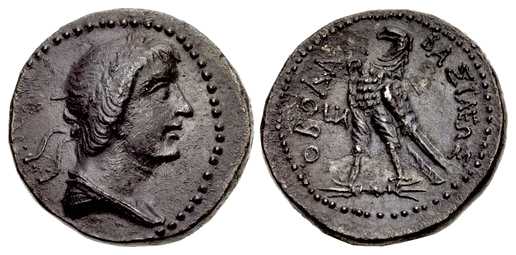Collection of Coins of The East & Africa
Obodas I Nabataea 96 BC - 86 BC
| This
extremely rare Nabataean drachm (v4689),
one of two examples known, raises several questions. The first is the
identity of the “Obodas” named as the issuer. Traditionally, three
Nabataean kings are thought to have been named Obodas: Obodas I (circa
96-86 BC), Obodas II (62-60 BC), and Obodas III (30-9 BC). This
chronology had remained unquestioned among scholars, even as recently
as 2002 when Jane Taylor (p. 219) published her Petra and the Lost
Kingdom of the Nabataeans. In 2010, however, Martin Huth ("Some
Nabataean Questions Reconsidered," in Coinage of the Caravan Kingdoms,
pp. 215–7), argued convincingly that only two kings of that name
existed, thus removing the previously-named Obodas II from the list of
monarchs. This chronological reassessment is a critical element in
securing the proper attribution of this drachm. Although the coins of Obodas II are relatively common, no coins have previously been assigned to Obodas I. The present coin is distinct in several respects from the coinage of Obodas II and almost certainly belongs to Obodas I. The fine Hellenistic style of the present coin is quite different from the many issues of Obodas II. The legend is in Greek rather than Aramaic. The weight is based on the Ptolemaic standard, unlike the coins of Obodas II, which are struck on the Phoenician standard. The form of the regnal date is likewise based on Ptolemaic practice. Furthermore, the reverse type of our coin would be entirely inappropriate for Obodas II (30-9 BC), considering the historical context of Obodas II’s reign. Under Malichus I (59-30 BC), the Nabataeans sided with Antony and Cleopatra against Herod I, defeating Herod in 32 BC at the Battle of Qanata. The following year, however, Nabataean fortunes changed; they were defeated by Herod of Judaea, and then the Nabataeans’ main allies Antony and Cleopatra were defeated at Actium. Following these defeats, the Nabataean kingdom under Obodas II became a client-state of Rome. The reverse of this drachm, with the eagle standing on a thunderbolt, is a recognizable "Egyptian" type, which, along with the Egyptian style date (LIA), would have recalled the alliance between the Nabataeans and the Ptolemaic kingdom under Cleopatra. For a Roman client-king to strike such a coin would have invited a crushing rebuke from his new Roman overlord. Yet, there is no evidence of this, and Obodas II appears to have enjoyed a long 21-year reign. All the evidence thus supports the attribution of this coin to Obodas I (circa 96-86 BC), and this coin of Regnal Year 11 should equate to the last year of his reign. Josephus (BJ 1.4.4) tells us that Obodas defeated the Hasmoneans, subsequently ambushing Alexander Jannaios (Yehonatan) near Gadara in revenge for the Nabataean loss of Gaza. In 86 BC, Obodas defeated the Seleukids at the Battle of Cana, at which Antiochos XII Dionysos was killed, and the Nabataeans conquered Damaskos, thereby increasing their power in the region. As a result, Obodas was venerated by the Nabataeans as a god and deified after his death, because he had defeated both the Hasmoneans and the Seleukids. This drachm was perhaps struck as a celebratory issue in the aftermath of Obodas' victory over the Seleukids, as the regnal date likely equates to the same year as this event. [CNG] |
 |
| SHH
v4689 |
| Obodas
/ Eagle AR 3.47 g 16 mm Meshorer --- CNG Triton XXI/526 |
